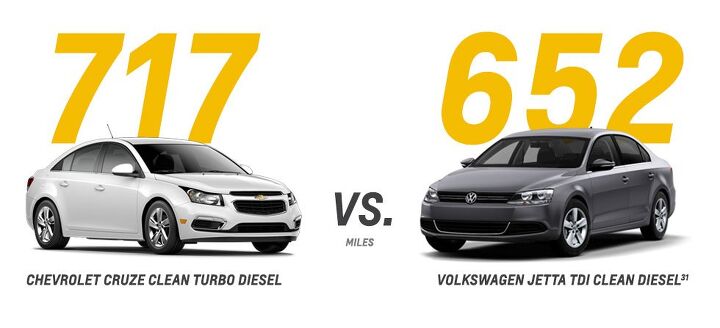Tech Dive: How the Chevy Cruze Diesel Stays Clean

Volkswagen may not be the only one that was cheating on their emissions testing. Reports coming out of the European Federation for Transport and Environment are shining light on other manufacturers which could be putting out dodgy emissions figures. I found the Vauxhall Zafira Tourer on one such report and decided to take a look at the Chevy Cruze Diesel due to related engine technology. I was surprised by what I found.
The Zafira Tourer can be equipped with a choice of two diesel engines. The lower trim features a 1.6-liter mill that produces 134 horsepower. The higher trim features a 2.0-liter engine that produces 163 horsepower. The 1.6-liter engine was mentioned in the T&E report as producing 9.5 times more emissions in their real world test than the law allows.
While General Motors may have some explaining to do for the 1.6-liter diesel in Europe, the 2.0-liter may actually be as clean as it promises.
The Cruze Diesel 2.0-liter engine is based on the one of the same size used in Europe, but many changes have been made including a new intake manifold, throttle body system and ceramic glow plugs. The fuel system was also modified to run at 1,600 PSI instead of the 2,000 PSI they see in Europe. Changes in the emissions programming were also made in order to meet U.S. emissions requirements. Both engines employ a diesel particulate filter (DPF) along with a urea injection system.
GM may have paved the way for a Volkswagen fix since they were able to lower the NOx output from their engine by making a few hardware changes and adjusting the emissions programming to reduce fueling. These changes are apparent when you look at the specs for the vehicles.
The European engine produces 163 hp and 260 lb.-ft. while the US engine produces 151 hp and 250 lb.-ft.
The fuel economy is also noticeably better for the European version with the heavier Zafira Tourer enjoying a 40 mpg combined rating while the Cruze Diesel is rated at 33 mpg combined by the EPA. All of these changes fall in line with a reduction in fuel injection timing. Reducing the timing causes a decrease in power and fuel economy, but also reduces the NOx output.
One other hint to the changes lies in the CO2 output ratings which put the Zafira Tourer at 220 grams per mile while the Cruze is at 307 grams per mile. This goes in line with a lower NOx output rating for the Cruze as due to the inverse relationship of CO2 and NOx output.
The dirty piece of reducing the injection timing is that more soot is created, which is why many are against such a fix for the Volkswagen diesels. This side effect is apparent in the Cruze as many have complained about soot buildup and the ability of the diesel regen cycle to clean it. The regen cycle in the Cruze burns additional diesel to heat up the particulate filter and clear out the soot, but dealers are running manual regens or increasing the regen cycle to help combat these issues due to the heavy soot build up on some vehicles. While the longer regen cycles will help to combat soot, they will also reduce the fuel economy as more diesel is dumped in order to heat up the filter.
The last piece of the puzzle lies with the aftermarket tuners and how much power they’ve been able to add with just a change in programming. The tuners were able to add 39 horsepower and 50 ft-lbs of torque to the Cruze without making any hardware changes, which likely equates to an advance in the fuel injection timing along with a change in the transmission torque management. The tuner further advertises that soot and DEF fluid usage are reduced while fuel economy is improved, which falls in line with a reduction of CO2 and an increase in NOx. The tuners have basically created a tune for the Cruze to turn into a calibration similar to what Volkswagen TDIs and the Euro-market Zafira Tourer are currently running.
[Image Credits: General Motors]

More by Bozi Tatarevic
Latest Car Reviews
Read moreLatest Product Reviews
Read moreRecent Comments
- FreedMike Not my favorite car design, but that blue color is outstanding.
- Lorenzo Car racing is dying, and with it my interest. Midget/micro racing was my last interest in car racing, and now sanctioning body bureaucrats are killing it off too. The more organized it is, the less interesting it becomes.
- Lorenzo Soon, the rental car lots will be filled with Kia's as far as the eye can see!
- Lorenzo You can't sell an old man's car to a young man, but you CAN sell a young man's car to an old man (pardon the sexism, it's not my quote).Solution: Young man styling, but old man amenities, hidden if necessary, like easier entry/exit (young men gradually turn into old men, and will appreciate them).
- Wjtinfwb Hmmm. Given that most Ford designs are doing relatively well in the marketplace, if this was forced I'd bet it was over the S650 Mustang. It's not a bad looking car but some angles seem very derivative of other makes, never a good trait for a car as distinctive as Mustang. And if he had anything to do with the abysmal dashboard, that's reason enough. Mustang doesn't need the "Tokyo by Night" dash arrangement of a more boring car. Analog gauges, a screen big enough for GPS, not Netflix and some decent quality plastics is plenty. The current set-up would be enough to dissuade me from considering a new Mustang.



































Comments
Join the conversation
Well I like my W123, how does it compare :P
I believe I’ll keep the 1.9l , 5 manual for a while •